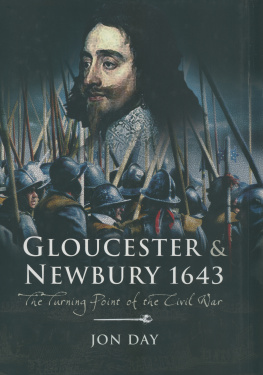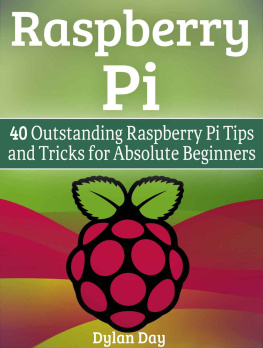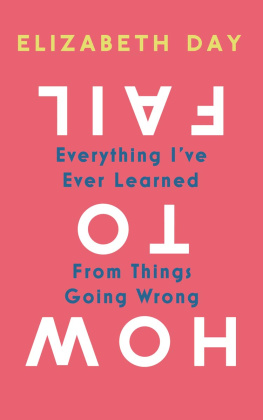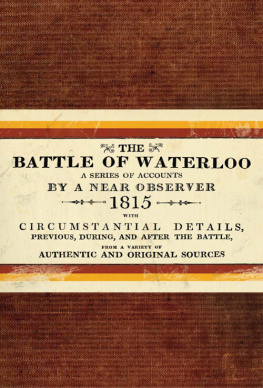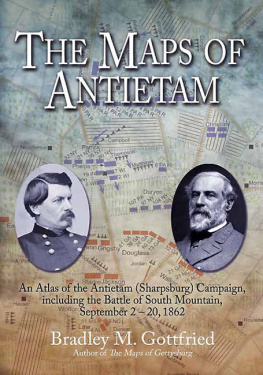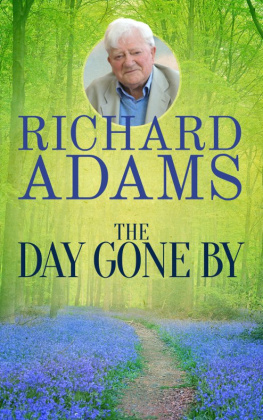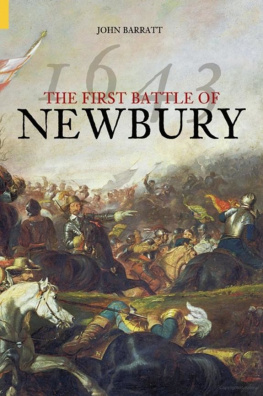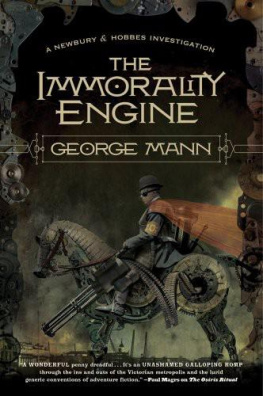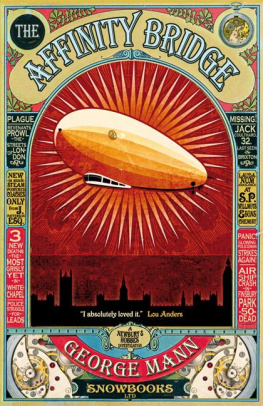Gloucester and
Newbury 1643
Gloucester and
Newbury 1643
The Turning Point of the Civil War
Jon Day

Pen & Sword
MILITARY
Pen & Sword Military
an imprint of
Pen & Sword Books Ltd
47 Church Street
Barnsley
South Yorkshire
S70 2AS
Copyright Jon Day 2007
ISBN: 978-1-84415-591-0
The right of Jon Day to be identified as
Author of this Work has been asserted by
him in accordance with the Copyright, Designs
and Patents Act 1988.
A CIP catalogue record for this book is
available from the British Library
All rights reserved. No part of this book may be reproduced or transmitted in any form
or by any means, electronic or mechanical including photocopying, recording or by any
information storage and retrieval system, without permission from the Publisher in
writing.
Typeset in 10/12pt Ehrhardt by Concept, Huddersfield
Printed and bound in England by Biddies Ltd
Pen & Sword Books Ltd incorporates the Imprints of Pen & Sword Aviation, Pen &
Sword Maritime, Pen & Sword Military, Wharncliffe Local History, Pen & Sword
Select, Pen and Sword Military Classics and Leo Cooper.
For a complete list of Pen & Sword titles please contact
Pen & Sword Books Limited
47 Church Street, Barnsley, South Yorkshire, S70 2AS, England
E-mail: enquiries@pen-and-sword.co.uk
Website: www.pen-and-sword.co.uk
Contents
Late summer 1643 was the military high tide for King Charles I and his armies. Battlefield victories in the North and West were followed by the storming of Englands second city, Bristol, and deep political crisis among his enemies in London. A year after England had descended from politics into conflict, this was the kings only realistic chance of winning his civil war. Yet within two months, the opportunity had been squandered. The Royalist armies failed to take the Parliamentarian stronghold of Gloucester, failed to prevent the Earl of Essex from relieving the city, failed to entrap the earls army in the Severn Valley and finally failed to defeat the Parliamentarians in battle at Newbury. Essex returned in triumph to a politically reunited London, the kings court descended into acrimonious recriminations and Parliaments eventual victory took on an increasing air of inevitability. If the Civil War had a turning point, this was surely it.
Despite its military and political importance, the campaign has been neglected by historians. At the strategic level, the apparent certainty of Parliaments victory has clouded judgements about its vulnerability during the campaign. With some honourable exceptions, 1643 is consequently seen as a dull period of stalemate between the more important battles of Edgehill and Marston Moor. The siege of Gloucester acquired the status of a romantic and symbolic myth, and in doing so became disconnected from the wider context and especially the consequent fight at Newbury. Because that battle did not follow the popular image of Civil War combat, and the complexities and contradictions of contemporary accounts were thought to defy detailed synthesis, it became seen as a tedious draw rather than a decisive combat, and was either ignored or misinterpreted.
For those seeking to fill this gap, there is a wealth of material on which to draw. Seventeenth-century accounts include a surprising number of eyewitness narratives, although all of them have a political or personal agenda of some kind. Much day-to-day correspondence has survived from both sides, offering fascinating though incomplete glimpses of individual perspectives and decision-making processes. Although Royalist intelligence material has to be deduced from the assessments contained in these letters, Sir Samuel Lukes letter book for the period contains the source material, raw intelligence reports from his network of Parliamentarian scouts and spies recorded as they arrived back at Essexs headquarters. It therefore shows what Essex knew of his enemies strength, intentions and movements throughout most of the campaign and can be tested against other information to assess the accuracy and impact of Lukes previously derided organisation. On logistics I have, I hope, made judicious use of Ian Roys selection from the Royalist Ordnance Papers; sadly, their Parliamentarian equivalents in the National Archives have not yet been similarly analysed. By contrast, Parliaments journals are complete though often tantalisingly sketchy, useful mainly for establishing chronology. The Oxford and London news books offer vivid pictures of how both sides reacted to events and sought to mould public opinion. They are often reflected in Venetian diplomatic reporting, which was generally shrewd though sometimes gullible and over-reliant on trusted but untrustworthy sources.
As with diplomatic despatches, landscape evidence should not be taken at face value. On close examination, virtually all of the campaigns key sites have changed beyond easy recognition, even where superficial similarities remain. It is, however, disappointing to discover how few modern writers seem to have visited the scenes of their imaginative reconstructions. The same omission applies to many early maps which I have found invaluable for interpreting events in pre-enclosure, pre-industrial England.
I have for the most part attempted to place my narrative in a contemporary context, concentrating on what was known then rather than relying on hindsight. My aim has been to weave the political, strategic, intelligence, logistic and tactical aspects of the campaign together more comprehensively than past histories, and explain what happened and why more clearly, especially in relation to the day-long encounter battle at Newbury. In doing so, I am suggesting a change to the traditional site of much of the fighting, away from Newburys modern suburbs to the neighbouring fields of Enborne. My account is not, however, definitive. Although Gloucesters defences and siege works have been partially excavated, my analysis of Newbury is (like all of its predecessors) unsupported by any archaeological evidence of the kind that is transforming our understanding of Naseby, Marston Moor and Edgehill. As I have emphasised in the final chapter, I hope very much that this gap can be filled in the coming years and that this book will help provide the stimulus for doing so.
I began work on Gloucester and Newbury in 1999 in the margins of a Ministry of Defence International Relations Fellowship at Harvard University, where a treasure trove of seventeenth-century material on the British civil wars kindled my interest, first in making sense out of the dense and apparently contradictory narratives of Newbury and then of the wider campaign. I am not a member of the academic or re-enactment communities, and have not therefore had the benefits (or disadvantages) that accrue from such networks. I am, however, extremely grateful to Glenn Foard of the Battlefields Trust for responding so positively to my cold call, and for the expert help and advice he has provided. I am also grateful to Stephen Ede-Borrett for reading and commenting on a draft of the text. The British Library, the various libraries at Harvard University, Winchester Library and the Berkshire, Gloucestershire, Hampshire and Wiltshire county record offices have all provided invaluable assistance. Steve Bloomfield at the Weatherhead Centre at Harvard gave me the latitude to go off-piste. Otherwise, I have relied on friends and family for everything apart from any errors, which are mine alone. Geoff Hocking designed the maps. Peter Ryan gave invaluable feedback on the text. Gill Comley was my equine expert. Assorted Hawkheads, Ryans and Comleys provided R&R. My brother Andrew also commented on a draft. My mother gave great moral support. Most importantly, my daughter Catherine was an occasional paid and unpaid research assistant, my wife Sandra tolerant and encouraging in equal measure, and they and my brother helped proof read and produce the index. I could not have completed the book without their inspiration and it is therefore dedicated to them both with my love.
Next page
